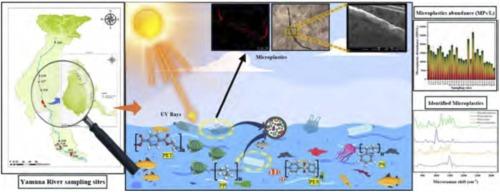亚穆纳河微塑料污染动态的多方面分析:评估人为影响和生态后果
IF 12.2
1区 环境科学与生态学
Q1 ENGINEERING, ENVIRONMENTAL
引用次数: 0
摘要
微塑料(MPs)是一种普遍存在的污染物,对生态和人类健康构成重大风险,是自然环境中最普遍的人为污染物之一。本研究调查了亚穆纳河中微塑料 (MPs) 的数量、特征和分布情况,涉及德里、马图拉、哈里亚纳邦和阿格拉及其周边的城市、农村和工业区的 29 个采样点。使用尼罗河红染色法和显微拉曼光谱对微塑料进行了鉴定和量化,微塑料的粒径分布主要在 2 μm 到 80 μm 之间,检测到的最大颗粒为 256.5 μm。MPs 的平均浓度为 14,717 ± 4,444 L-1,其中大量存在有害聚合物,如聚对苯二甲酸乙二酯(PET)、聚丙烯(PP)和聚苯乙烯(PS)。研究发现,MPs 主要是碎片和薄膜(65.6%)以及纤维(30.6%),其中透明颗粒最为普遍。污染负荷指数(PLI)在所有采样点都持续显示出高风险水平(PLI > 100),凸显出大量 MP 污染。这些结果表明,迫切需要对亚穆纳河进行持续监测并制定强有力的管理策略,以解决亚穆纳河的微塑料污染问题。这项研究提供了有关 MP 空间分布和持久性的宝贵见解,有助于更好地了解其对环境的影响,并指导未来的缓解和监管工作。本文章由计算机程序翻译,如有差异,请以英文原文为准。

Multifaceted Analysis of Microplastic Pollution Dynamics in the Yamuna River: Assessing Anthropogenic Impacts and Ecological Consequences
Microplastics (MPs) are pervasive contaminants that pose significant ecological and human health risks, emerging as one of the most widespread anthropogenic pollutants in natural environments. This study investigates the abundance, characteristics, and distribution of microplastics (MPs) in the Yamuna River, encompassing 29 sampling points across urban, rural, and industrial zones in and around Delhi, Mathura, Haryana, and Agra. Microplastics were identified and quantified using Nile red dye staining and Micro-Raman spectroscopy, with particle size distribution predominantly between 2 μm to 80 μm and the largest detected particle measuring 256.5 μm. The average MPs concentration was 14,717 ± 4,444 L−1, with a significant abundance of hazardous polymers such as polyethylene terephthalate (PET), polypropylene (PP), and polystyrene (PS). The study found that MPs were predominantly fragments and films (65.6%) and fibers (30.6%), with transparent particles being the most prevalent. The Pollution Load Index (PLI) consistently indicated high-risk levels (PLI > 100) at all sampling sites, highlighting substantial MP contamination. These results underscore the urgent need for continuous monitoring and the development of robust management strategies to address microplastic pollution in the Yamuna River. This study provides valuable insights into MPs spatial distribution and persistence, contributing to an improved understanding of their environmental impacts and guiding future mitigation and regulatory efforts.
求助全文
通过发布文献求助,成功后即可免费获取论文全文。
去求助
来源期刊

Journal of Hazardous Materials
工程技术-工程:环境
CiteScore
25.40
自引率
5.90%
发文量
3059
审稿时长
58 days
期刊介绍:
The Journal of Hazardous Materials serves as a global platform for promoting cutting-edge research in the field of Environmental Science and Engineering. Our publication features a wide range of articles, including full-length research papers, review articles, and perspectives, with the aim of enhancing our understanding of the dangers and risks associated with various materials concerning public health and the environment. It is important to note that the term "environmental contaminants" refers specifically to substances that pose hazardous effects through contamination, while excluding those that do not have such impacts on the environment or human health. Moreover, we emphasize the distinction between wastes and hazardous materials in order to provide further clarity on the scope of the journal. We have a keen interest in exploring specific compounds and microbial agents that have adverse effects on the environment.
 求助内容:
求助内容: 应助结果提醒方式:
应助结果提醒方式:


